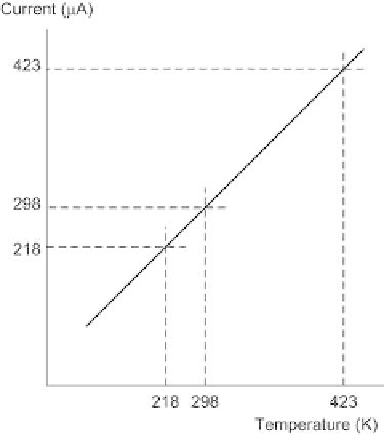Hardware Reference
In-Depth Information
Figure 9.24
Characteristic of the AD590 semiconductor temperature sensor
Semiconductor temperature sensors
Semiconductor temperature sensors are ideal for a wide range of temperature-
sensing applications. The popular AD590 semiconductor temperature sensor,
for example, produces an output current which is proportional to absolute tem-
perature and which increases at the rate of 1
µ
A/K. The characteristic of the
device is illustrated in Figure 9.24.
The AD590 is laser trimmed to produce a current of 298.2
µ
A(
2.5
µ
A) at
a temperature of 298
.
2
◦
C (i.e. 25
◦
C). A typical interface between the AD590
and an analogue port is shown in Figure 9.25.
Figure 9.25
Typical input
interface for the AD590
semiconductor temperature
sensor
Thermocouples
Thermocouples comprise a junction of dissimilar metals which generate an
e.m.f. proportional to the temperature differential which exists between the
measuring junction and a reference junction. Since the measuring junction
is usually at a greater temperature than that of the reference junction, it is
sometimes referred to as the
hot junction.
Furthermore, the reference junction
(i.e. the
cold junction)
is often omitted in which case the sensing junction
is simply terminated at the signal conditioning board. This board is usually
maintained at, or near, normal room temperatures.
Thermocouples are suitable for use over a very wide range of tempera-
tures (from
−
100
◦
Cto
+
1100
◦
C). Industry standard 'type K' thermocouples
comprise a positive arm (conventionally coloured brown) manufactured from
nickel/chromium alloy whilst the negative arm (conventionally coloured blue)
is manufactured from nickel/aluminium.
The characteristic of a type K thermocouple is defined in BS 4937 Part 4 of
1973 (International Thermocouple Reference Tables) and this standard gives



